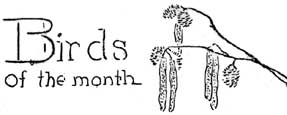
|
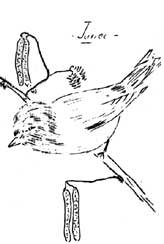
|
Spring is just around the corner. One needs but to look and listen to
become aware of that for the melodius metallic whistle of the Varied
Thrush ringing down the long corridors of the forests that clothe our
hills is announcing the season's arrival. Nature's moods are full of
variety but even so we shall never tire of the Varied Thrush. His song
is too typical of the wild freedom of the woods; his appearance to
descriptive of the pleasant days that follow his coming. In fact he
eclipses his cousin, the Robin, in this respect on "The Mountain". We
see many of them at Longmire now. They are easily identified by the
bright orange-yellow breast that is possessed of a sharply contrasting
black band, and the orange-yellow markings upon the wings and head.
|
Pine Siskins, whose presence in this vicinity has been noted for
several weeks, seem to be more numerous. Watching a large flock of these
birds in a Cottonwood grove recently we were reminded, by their nervous
movements as they fluttered about from branch to branch, of windblown
leaves in the fall for their small size and general streaked brownish
color made them appear as such. They seemed to be hardly still for a
moment and then they would rise in unison into the air with a whir of
wings -- only to return again to their original perch soon after. Then
there are the Juncoes. About the size of a Sparrow their black head and
throat and white streaks upon the tail (the latter being much in
evidence in flight) they are readily recognized.
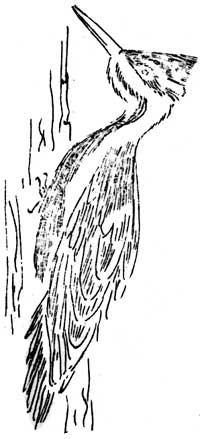 The most noteworthy visitor, however, during the past month is the
Pileated Woodpecker. One of these giants of the woodpecker clan has been
keeping such close watch on the trees about the Museum that it would
seem to be inadviseable to venture about the building without a hat.
Anyone who has seen this bird and watched him in his search for grubs
will readily appreciate that statement for he can use that powerful beak
of his much like a woodsman does an axe. Striking from side to side he
removes large plates of bark and if he finds a grub -- well it will
still be a grub but in a different sense. The large size and conspicuous
though ungainly appearance readily identifies him. He is about the size
of a Crow; jet black except for a bright red crown patch and white
markings upon the side of the head and along the neck. He is a dweller
of the deep woods and rather scarce although here in the Park we often
see them but his wariness -- for he is adept at keeping on the opposite
side of a tree trunk -- is not conducive of photos in a characteristic
pose.
The most noteworthy visitor, however, during the past month is the
Pileated Woodpecker. One of these giants of the woodpecker clan has been
keeping such close watch on the trees about the Museum that it would
seem to be inadviseable to venture about the building without a hat.
Anyone who has seen this bird and watched him in his search for grubs
will readily appreciate that statement for he can use that powerful beak
of his much like a woodsman does an axe. Striking from side to side he
removes large plates of bark and if he finds a grub -- well it will
still be a grub but in a different sense. The large size and conspicuous
though ungainly appearance readily identifies him. He is about the size
of a Crow; jet black except for a bright red crown patch and white
markings upon the side of the head and along the neck. He is a dweller
of the deep woods and rather scarce although here in the Park we often
see them but his wariness -- for he is adept at keeping on the opposite
side of a tree trunk -- is not conducive of photos in a characteristic
pose.
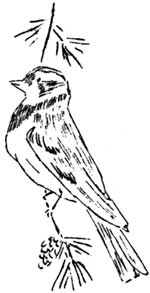 Early in the winter a feeding board was placed near one of the Museum
windows in order that birds might be attracted to that point. At first
only Jays and Camp Robbers were regular feeders but soon others became
aware of the permanant "handout". The other day, while working upon some
Nature Bulletins, to be used on our Nature Trails next summer, the
writer noticed -- all within a few minutes -- the following birds;
several Camp Robbers, Stellar Jays, a male and female Harris Woodpecker,
a Downy Woodpecker (smallest woodpecker in the Park), a dozen or so
Chestnut Backed Chickadees, a Junco, three or four Kinglets and a
Nuthatch. A Crow and a Raven were seen a short distance away and a
Creeper was exploring a nearby tree trunk for grubs. The feeding board
has been the source of much material for past issues of these Nature
Notes.
Early in the winter a feeding board was placed near one of the Museum
windows in order that birds might be attracted to that point. At first
only Jays and Camp Robbers were regular feeders but soon others became
aware of the permanant "handout". The other day, while working upon some
Nature Bulletins, to be used on our Nature Trails next summer, the
writer noticed -- all within a few minutes -- the following birds;
several Camp Robbers, Stellar Jays, a male and female Harris Woodpecker,
a Downy Woodpecker (smallest woodpecker in the Park), a dozen or so
Chestnut Backed Chickadees, a Junco, three or four Kinglets and a
Nuthatch. A Crow and a Raven were seen a short distance away and a
Creeper was exploring a nearby tree trunk for grubs. The feeding board
has been the source of much material for past issues of these Nature
Notes.

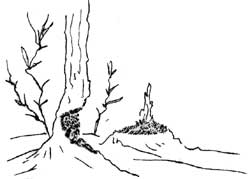 But a few years ago Beaver in the Park were scarce. Their numbers were
few and their workings were removed from the casual eye. Now, however,
they seem to be quite definitly on the increase. Ranger Carl Tice found
one new colony on a small tributary of the Nisqually, but a short
distance from the highway. Here they have constructed a fairly elaborate
system of dams and have been working on -- not only the Cottonwood and
Alder as is usually the case -- a but upon Cedar as well. Beaver in this
Park rarely build the characteristic lodges. They burrow in the banks of
the streams constructing suitable homes in that manner.
But a few years ago Beaver in the Park were scarce. Their numbers were
few and their workings were removed from the casual eye. Now, however,
they seem to be quite definitly on the increase. Ranger Carl Tice found
one new colony on a small tributary of the Nisqually, but a short
distance from the highway. Here they have constructed a fairly elaborate
system of dams and have been working on -- not only the Cottonwood and
Alder as is usually the case -- a but upon Cedar as well. Beaver in this
Park rarely build the characteristic lodges. They burrow in the banks of
the streams constructing suitable homes in that manner.

